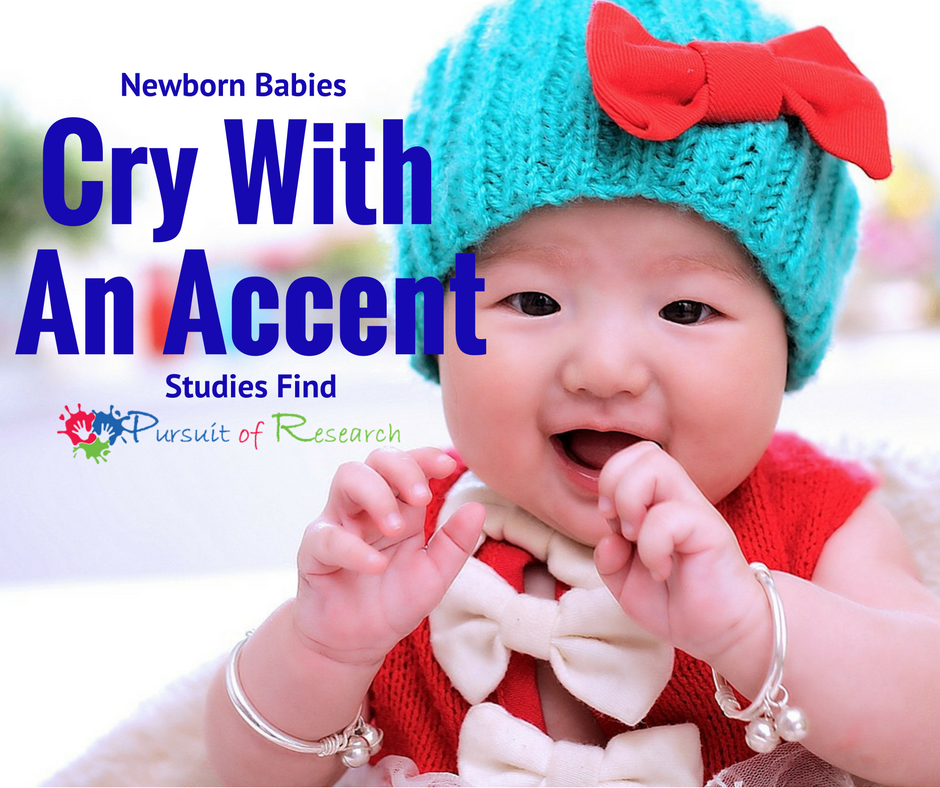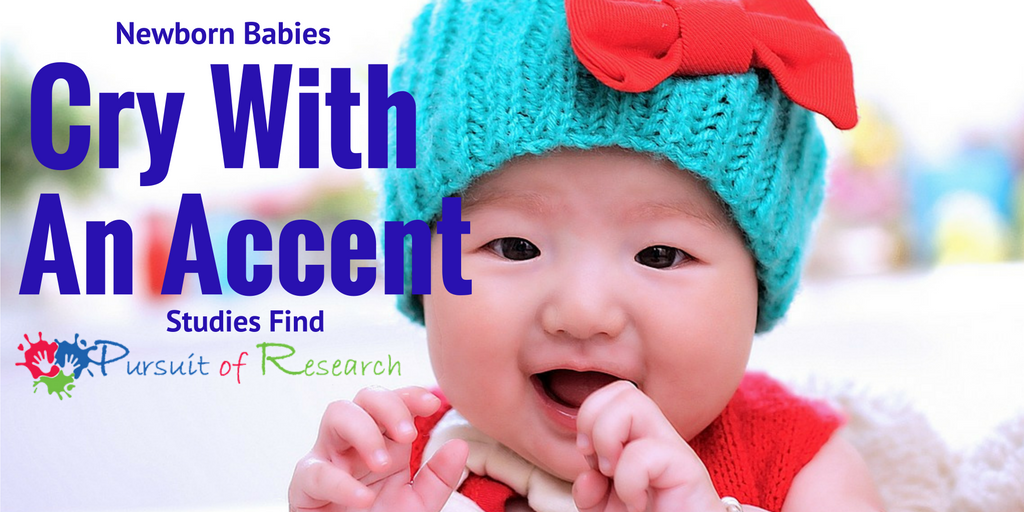“Newborns are likely highly motivated to imitate their mothers in order to enhance bonding” ~Kathleen Wermke PhD
Language begins with the very first cry
A study published in 2009 in the journal Current Biology suggested crying infants may be imitating the patterns of the language they heard while in the womb. Essentially they found babies from birth cry with an accent.
This 2009 study of over a thousand recorded cries from 30 French newborns and 30 German newborns found differences in the cries’ melody patterns. French cries tended to have a rising melody, while the German cries tended to have a falling melody.
The finding suggests that newborns just a few days old may already be trying to imitate the prevailing intonation patterns of the language they heard while still in the womb.
According to the lead researcher Kathleen Wermke PhD of the Center for Prespeech Development and Developmental Disorders at the University of Wurzburg in Germany, newborns are likely highly motivated to imitate their mothers in order to enhance bonding.
Dr. Wermke’s New Study: Baby’s cry -tonal vs not tonal
Dr. Wermke’s new study just published August 2016 looked at the difference in cries between languages that are tonal vs not tonal. English and German are examples of language that are non- tonal.
To explain a tonal language I found this quote
“Take the word ma.
- If you say it the way an English-speaker would say it, just reading it sitting by itself on a page, then it means “scold.”
- Say ma as if you were looking for your mother—ma?—and it means “rough.”
- If you were just whining at her—“ma-a-a?!?”—with your voice swooping down a bit and then back up even higher, that would mean, believe it or not, “horse.”
- And if you say ma on a high pitch, as if you were singing the first syllable of “The Star-Spangled Banner” as ma instead of “oh” for some reason, that would actually mean mother.
That’s the way almost every syllable works in Chinese.”
The new study is in German -so here it is translated via Google translate. Due to this there may be some errors in grammar.
Native impressed Baby sounds
8/18/2016
Even the first cries of newborn bears traces of the native language. This is evident in languages in which pitch or change in pitch determine the meaning of words, obviously particularly clear – as a team of scientists under Würzburg guide for the first time has shown.
For European ears sound tonal languages unaccustomed: unlike for example in German, French or English with them also carry the pitches where syllables or words are pronounced, the importance. The seemingly equal loudness can therefore completely different things designate – depending on whether it is pronounced in a high or low pitch or with a special tone movement.
Tonal languages in China and Africa
The standard Chinese or Mandarin is an example of such a tonal language. The official language of China is mainly spoken in China, Taiwan and Singapore – currently of more than one billion people. Four characteristic tones must master, who wants to speak this language.
Significantly more complicated Nso language, the language of the Nso – a nation of estimated 280,000 people in northwest Cameroon live mainly in hilltop villages of the grasslands and operate there agricultural. The complex tonal language has eight notes, many of which also vary in shape. In other words: If you want to talk Nso language perfectly, should not only be able to make the perfect tones, but also incorporate even specific pitch evolutions in certain words.
When Pregnant address such complex tonal languages: to show the wines in their newborns? This question have explored now in a project scientists from different countries. The results of their studies they have in the current editions of the journals Speech, Language and Hearing and the Journal of Voice published.
The crying is like how the tonal languages a singsong
The result: “The crying of newborns whose mothers speak a tonal language, shows a significantly stronger melodic variation, for example, compared with German newborns,” says Professor Kathleen Wermke, director of the Centre for Pre-Development and Developmental Disorders at the University Hospital Würzburg (Department of Orthodontics ) and lead author of both studies.
So the children of Nso in Cameroon was not only the “innerlautliche total variation of pitch”, ie the distance between the deepest and the highest sound significantly larger; also the brief rise and fall of sounds during utterance fell from intensive compared to the newborns of German mothers. “Her crying was more like a singsong” Wermke describes this effect. Similarly, saw the results from in newborns from Beijing – though pronounced slightly weaker.
Language from the start
To the researchers, this finding suggests a theory that they had seen confirmed when comparing German and French newborn: “The acquisition of blocks for later language begins at birth; not when babies begin to babble or first words produce “, says the scientist.
After they had ample opportunity during the last trimester of pregnancy, to know their “mother tongue” in the womb, show newborns in their wines characteristic melodic patterns of the area – just like the native language – are affected, and the even before they coo first sounds or try the speech-like “syllable babbling”.
Study continued below, but I was curious to see if I heard a difference, and I’m sure you are too. I found some videos of newborns that are crying from what I believe to be the countries I have listed (again thank you Google translate)
Newborn where the language is Chinese
Newborn where the language is English
Newborn where the language is French
Newborn where the language is German
Newborn where the language is Thai
How to comfort a baby regardless of language
Same findings across cultures
Simultaneously, the research results for a high degree of time talking to universality in the vocalizations of babies across cultural boundaries.
“We have in this case examined from very different cultural backgrounds newborns,” says Kathleen Wermke. There are on the one hand newborns from Beijing, surrounded by all the influences of modern civilization – have grown – radio, television, smartphone. the children of Nso who have come in a rural environment to the world in which it is missing on the other side of all technical achievements of modernity.
“The fact that in spite of these differences in the cultures show similar effects in the two tonal language groups compared to the non-tonal German group, suggests that our interpretation of the data in the right direction,” said the scientist.
Carefully worded could suggest even the conclusion these results demonstrate that not only external but also genetic factors are mitbeteiligt here. “Of course, it is undisputed that newborns are able to learn any spoken language in the world, regardless of how complex it is,” says Kathleen Wermke.
Basis for the early diagnosis of disorders
55 newborns from Beijing and 21 from Cameroon have examined the scientists in their studies and recorded their vocalizations during the first days of life. the babies were not brought extra cry for granted. “We have recorded only spontaneous vocalizations, usually whenever a baby was noticeable because it was hungry,” says Kathleen Wermke.
To the researchers, the results of these studies contribute to a better understanding of key factors affecting the earliest stages of language development than was previously the case. This improves also the ability to identify early indicators that can provide information about possible developmental problems in this area at a very early stage reliable. Up to a clinical application, however, numerous other issues had to be clarified.
Fundamental frequency variation within neonatal crying: Does ambient language matter? Kathleen Wermke, Johanna Teiser, Eunice Yovsi, Paul Joscha Kohlberg, Peter Wermke, Michael Robb, Heidi Keller & Bettina Lamm. Speech, Language and Hearing, dx.doi.org/10.1080/2050571X.2016.1187903
Fundamental Frequency variation in Crying of Mandarin and German Neonates. Kathleen Wermke, Yufang Ruan, Yun Feng, Daniela Dobnig, Sophia Stephan, Peter Wermke, Li Ma, Hongyu Chang, Liu Youyi, Volker Hesse, and Hua Shu. Journal of Voice, dx.doi.org/10.1016/j.jvoice.2016.06.009
Prof. Kathleen Wermke
Dr. Kathleen Wermke received her PhD in the field of behavioral physiology at the Humboldt University of Berlin (Germany) in 1986. From 1986 until 2003, she worked as a research fellow at the University Hospital (Charité) in Berlin, where her researche focused on investigating infant sounds and early language development. During that period, she also gave lectures to medical students on a broad range of biological topics. In July 2002, she received a post-doctoral qualification (Habilitation) in medical anthropology from the Medical Department of the Humboldt University. The following year, she was appointed Founding Director of the Center for Pre-Speech Development and Developmental Disorders at the Julius-Maximilians-University in Würzburg (Germany). The Center is dedicated to researching early language development, particularly during the first year of infant life. It also provides pre-speech diagnosis for infants and young children at risk for speech and language development impairments, particularly for infants with cranio-/oro-facial clefts or sensorineural hearing impairment (collaboration with the Comprehensive Hearing Center).
Source
If interested in the difference of babies globally I highly recommend the documentary Babies

